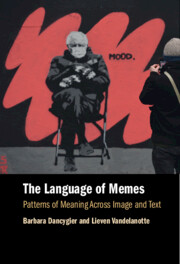Refine search
Actions for selected content:
2 results

The Language of Memes
- Patterns of Meaning Across Image and Text
-
- Published online:
- 12 September 2025
- Print publication:
- 11 September 2025
12 - One Does Not Simply Draw a Conclusion
-
- Book:
- The Language of Memes
- Published online:
- 12 September 2025
- Print publication:
- 11 September 2025, pp 217-233
-
- Chapter
- Export citation
